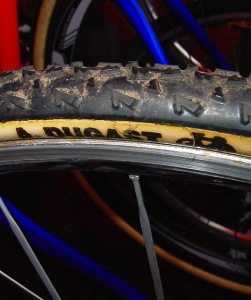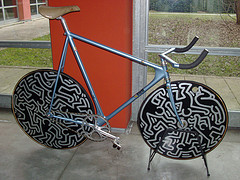
Occasionally, people ask me why I don’t more actively seek out work in the cycling industry. Aside from the fact that it’s an insider’s game and I’ve got the schmoozing skills of a dyspeptic orangutan, there’s just no way I could bring myself to participate in the absolute nonsense the positions tend to require—all the more so when that nonsense runs contrary to the interests of the company I would hypothetically be supporting.
Case in point—the sidewalls of the pro cyclocross bikes making the rounds on cycling news websites the past few weeks. While I applaud the spirit of whichever mechanic or press agent decided to turn Ryan Trebon’s sidewalls into a massive, garish Clement ad, it’s pretty clear no one was fooled by the effort. And while I’m sure the people at QBP smiled warmly at James Huang’s insistance that the uproariously camouflaged Dugast was merely a placeholder, it sure doesn’t look like the Typhoon has been cut from Treefarm’s arsenal.
Maxxis has at least taken a step in the correct direction—kinda. It seems a more-than-open-secret (mentioned at least twice) that Geoff Kabush is running tubulars with a Maxxis tread, but glued to a Dugast casing. To my consumer’s eye, that’s awesome step forward, and one Maxxis should be touting. But instead they’ve Sharpied over the sidewalls, lest the random passer-by find out what anyone who might possibly buy these (unbuyable) tires already knows.
It’s bad enough that blacked out sidewalls scream “we’re trying to cover something up”. But when you consider the unbelievable history of iconic brand crossovers, it’s almost criminal that anyone could pass an opportunity to advertise their racers on the Shelby GT of cyclocross tires. It’d be like Cinelli or Trek attributing the artwork on their iconic machines to “some contemporary artist” to save the feelings of their in-house designers.

As The Economist noted, brand is critical in cycling—and if you can clothe yours in the finery of someone else’s, all the better. Perhaps some tire makers out there still consider Dugast and FMB to be “competitors”. And maybe, if it takes you three weeks to turn out 20 tires at $350 a pair, letting people know your top riders race on someone else’s casing might be a mistake. But for most of the industry, churning out affordable rubber in industrial quantities, a sewing a little free advertising for the boutiques into your team equipment will come back in positive brand association at the bike shop ten-fold.
Of course, racers and brand managers would still—at least for the first few seasons—have to answer questions from fans and press about the (OMG) off-brand equipment. Aside from stressing the talking points that casings are just part of a tire, and that FMB buys both tubes and treads from somewhere else, here are some blurbs that everyone should feel free to crib:
“Obviously, [sponsor] has the best tire arsenal on the market today. But when you pair [sponsor]’s treads with this custom casing, [tread name] really is the ultimate weapon”
“99 times out of 100, [sponsor]’s stock tires are the best thing out there. These custom casing models are a huge investment on the part of [sponsor] to cover the remaining 1%.”
“These tires are really indicative of the support we’re getting from [sponsor]. These are the best casings out there, and [sponsor]’s tread is a decade ahead of where the stock rubber is.”
“You couldn’t be competitive in today’s field without custom casings. And thanks to [sponsor]’s tread pattern, today’s field couldn’t be competitive with me.”
There was once a day when sponsorship was 100% about advertising. When differences between production models and custom machines came down to minute subtleties in lugs and steel, and when the public’s only window onto them was a small collection of low-resolution photos, the only thing that mattered—the only legible detail, really—was the name on the downtube.
But in the modern era, where every pocket holds a combination high resolution camera and instant publishing platform, and where fans are bombarded with a constant flood of information, I think the idea of cycling sponsorship really has to evolve from the purchase of rolling billboards to a more holistic concept of rider support.
This isn’t to say that riders should be able to run whatever the heck they want no questions asked, but if a rider competing at the top level feels that in certain conditions, they need a certain part to be competitive, a good sponsor will be willing to make a concession—just like Maxxis has done for Kabush. Now it’s time for the marketing side of the equation to catch up.
I have trouble finding any news here. Putting the (money-paying) sponsor’s name on equipment produced by others has been going on for almost ever. Eddy Merckx putting his name on frames made by DeRosa or Colnago, clothing sponsors names attached to clothing produced by another company, all the way to today when a certain Italian carbon frame builder makes made-to-measure frames that look just like the Chinese-made brands who put up the big cash. It’s harder to get away with these days so less people are fooled, but as long as someone thinks they need something special/different to win races, it will continue. Same as it ever was.